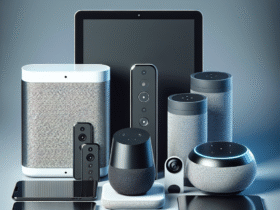Best Phone Camera Systems 2025: Complete Review of Smartphone Photography Revolution
Smartphone cameras have evolved from simple communication tools to professional-grade photography systems that rival dedicated cameras. The 2025 landscape showcases groundbreaking computational photography, multi-lens arrays, and AI-powered features that are transforming how we capture and create visual content. This comprehensive review examines the most innovative phone camera systems available, evaluating image quality, versatility, and real-world performance across different shooting scenarios.
The Smartphone Camera Revolution
Beyond Megapixels: What Really Matters in 2025
The megapixel race has given way to sophisticated computational photography that combines hardware excellence with AI processing power. Modern phone cameras excel through sensor technology, lens quality, image processing algorithms, and software intelligence.
Key Technologies Driving Camera Excellence:
- Large sensor technology with improved light gathering capability
- Computational photography merging multiple exposures instantly
- AI-powered scene recognition and optimization
- Advanced optical image stabilization systems
- Professional-grade lens coatings and construction
- Real-time HDR processing and tone mapping
Camera System Categories
Smartphone manufacturers have developed distinct approaches to camera excellence, each optimizing for different user needs and photographic styles.
Camera System Types:
- Computational Leaders: AI-first processing with software optimization
- Hardware Maximalists: Largest sensors and premium optics
- Professional Tools: Manual controls and pro-grade features
- Social Media Optimized: Portrait and selfie-focused systems
- Versatility Champions: Multiple focal lengths and shooting modes
Flagship Camera System Leaders
1. iPhone 15 Pro Max Camera System
Price: $1,199-$1,599 | Camera Rating: 4.8/5 stars
Apple’s iPhone 15 Pro Max represents the pinnacle of computational photography, combining excellent hardware with industry-leading image processing that consistently delivers professional-quality results across all shooting conditions.
Camera Hardware Specifications:
- Main Camera: 48MP with f/1.78 aperture, sensor-shift OIS
- Ultra-Wide: 12MP with f/2.2 aperture, 120° field of view
- Telephoto: 12MP with f/2.8 aperture, 3x optical zoom
- Front Camera: 12MP with f/1.9 aperture, autofocus
- Video Capabilities: 4K ProRes, Action mode stabilization
Computational Photography Excellence:
- Smart HDR 5: Intelligent exposure balancing in challenging lighting
- Photographic Styles: Customizable processing presets
- Night mode: Automatic low-light enhancement across all lenses
- Portrait mode: Professional depth-of-field with multiple lighting effects
- Macro photography: Ultra-wide lens doubles as macro with 2cm focusing
Real-World Performance:
- Daylight Photography: Exceptional dynamic range and color accuracy
- Low Light: Industry-leading noise reduction and detail preservation
- Portrait Photography: Natural bokeh with accurate edge detection
- Video Quality: Professional stabilization and color grading
- Consistency: Reliable results across all shooting scenarios
Pros & Cons:
✅ Best-in-class computational photography
✅ Exceptional video quality and stabilization
✅ Consistent performance across all lenses
✅ Intuitive camera app with professional features
❌ Limited zoom range compared to competitors
❌ Premium pricing for full feature access
❌ Slower charging speeds than Android rivals
2. Samsung Galaxy S24 Ultra Camera System
Price: $1,299-$1,659 | Camera Rating: 4.7/5 stars
Samsung’s Galaxy S24 Ultra pushes the boundaries of smartphone zoom photography while delivering excellent results across all focal lengths. The integration of AI processing with hardware excellence creates a versatile photography powerhouse.
Advanced Camera Array:
- Main Camera: 200MP with f/1.7 aperture, dual pixel PDAF
- Ultra-Wide: 12MP with f/2.2 aperture, 120° field of view
- Telephoto 1: 10MP with f/2.4 aperture, 3x optical zoom
- Telephoto 2: 50MP with f/3.4 aperture, 5x optical zoom
- Front Camera: 12MP with f/2.2 aperture
AI Photography Features:
- AI Zoom: 100x Space Zoom with computational enhancement
- Expert RAW: Professional controls with computational processing
- Nightography: AI-enhanced low-light performance
- Object Eraser: AI-powered content removal tool
- Motion Photo: Live photo capture with enhanced stabilization
Zoom Photography Excellence:
- 3x Zoom: Excellent detail and color reproduction
- 5x Zoom: Sharp images with minimal quality loss
- 10x Zoom: Usable quality for social media and documentation
- 30x+ Zoom: Impressive reach for wildlife and distant subjects
Assessment: The S24 Ultra excels in versatility and zoom capability, making it ideal for users who need maximum flexibility in their photography. The AI features, while sometimes overly aggressive, provide creative possibilities unavailable elsewhere.
3. Google Pixel 8 Pro Camera System
Price: $999-$1,299 | Camera Rating: 4.6/5 stars
Google’s Pixel 8 Pro continues the company’s tradition of computational photography leadership, using advanced AI and machine learning to extract maximum quality from relatively modest hardware specifications.
Computational Photography Pioneer:
- Main Camera: 50MP with f/1.68 aperture, OIS
- Ultra-Wide: 48MP with f/1.95 aperture, autofocus
- Telephoto: 48MP with f/2.8 aperture, 5x optical zoom
- Front Camera: 10.5MP with f/2.2 aperture
AI-Powered Features:
- Magic Eraser: Advanced object removal with context filling
- Real Tone: Accurate skin tone representation across ethnicities
- Night Sight: Revolutionary low-light computational photography
- Astrophotography: Specialized mode for night sky photography
- Live Translate: Real-time text translation through camera
Photography Strengths:
- Portrait Photography: Natural-looking background blur and lighting
- Low-Light Performance: Class-leading noise reduction and detail
- Color Science: Realistic, pleasing color reproduction
- Ease of Use: Point-and-shoot simplicity with professional results
Mid-Range Camera Excellence
4. Nothing Phone (2a) Camera System
Price: $399-$499 | Camera Rating: 4.2/5 stars
Nothing’s approach to smartphone cameras focuses on clean, natural image processing that avoids over-saturation and artificial enhancement, appealing to users who prefer authentic-looking photographs.
Minimalist Camera Philosophy:
- Main Camera: 50MP with f/1.88 aperture, OIS
- Ultra-Wide: 50MP with f/2.2 aperture, 114° field of view
- Front Camera: 32MP with f/2.2 aperture
Natural Photography Approach:
- Minimal computational processing for authentic results
- Excellent dynamic range in good lighting conditions
- Clean, noise-free images with natural color grading
- Simple camera interface focusing on core photography
5. OnePlus 12 Camera System
Price: $899-$999 | Camera Rating: 4.4/5 stars
OnePlus has partnered with Hasselblad to develop a camera system that balances computational photography with natural color science, targeting enthusiast photographers seeking manual control options.
Hasselblad Collaboration Features:
- Main Camera: 50MP with f/1.6 aperture, OIS
- Ultra-Wide: 48MP with f/2.2 aperture, 114° field of view
- Telephoto: 64MP with f/2.6 aperture, 3x optical zoom
- Front Camera: 32MP with f/2.4 aperture
Photography Performance:
- Color Accuracy: Hasselblad-tuned color profiles
- Manual Controls: Pro mode with extensive customization
- Speed: Fast autofocus and zero shutter lag
- Versatility: Strong performance across all focal lengths
Specialized Camera Phone Categories
Content Creator Focused Systems
6. Sony Xperia 1 V Camera System
Price: $1,399 | Camera Rating: 4.5/5 stars
Sony brings professional camera technology from their Alpha series to smartphones, offering unmatched manual controls and professional features for serious photography enthusiasts.
Professional Camera Features:
- Main Camera: 48MP with f/1.9 aperture, dual pixel PDAF
- Ultra-Wide: 12MP with f/2.2 aperture, 16mm equivalent
- Telephoto: 12MP with f/2.3-f/3.5 aperture, variable zoom
- Video Capabilities: 4K 120fps, professional video controls
Professional Photography Tools:
- Photography Pro: Manual controls matching Sony Alpha cameras
- Real-time tracking: Advanced subject tracking autofocus
- RAW capture: Unprocessed files for post-production flexibility
- Cinema Pro: Professional video recording with manual controls
Budget-Conscious Options
7. Google Pixel 7a Camera System
Price: $499 | Camera Rating: 4.3/5 stars
The Pixel 7a brings flagship-level computational photography to the mid-range market, offering exceptional value for users prioritizing camera quality over premium build materials.
Flagship Features at Mid-Range Price:
- Main Camera: 64MP with f/1.89 aperture, OIS
- Ultra-Wide: 13MP with f/2.2 aperture
- Front Camera: 13MP with f/2.2 aperture
Computational Photography Benefits:
- Full Pixel computational photography suite
- Magic Eraser and other AI-powered tools
- Excellent low-light performance
- Portrait mode with accurate edge detection
Camera Performance Analysis by Use Case
Social Media Photography
For users primarily sharing on Instagram, TikTok, and other social platforms, certain camera features provide the most value.
Social Media Priorities:
- Selfie Quality: Front camera resolution and beauty filters
- Portrait Mode: Background blur for professional-looking selfies
- Video Stabilization: Smooth footage for social media content
- Instant Editing: Built-in filters and editing tools
- Quick Sharing: Fast processing and upload speeds
Top Social Media Cameras:
- Best Overall: iPhone 15 Pro for consistency and ease of use
- Best Selfies: Samsung Galaxy S24 Ultra with wide front camera
- Best Video: iPhone 15 Pro Max with superior stabilization
- Best Value: Google Pixel 7a for computational photography
Professional and Creative Photography
For serious photographers and content creators, manual controls and professional features become essential.
Professional Requirements:
- Manual Controls: Full control over exposure, focus, and white balance
- RAW Capture: Unprocessed files for maximum editing flexibility
- Multiple Focal Lengths: Variety of perspectives without carrying multiple lenses
- Video Features: 4K recording with professional codecs
- Color Accuracy: Consistent, accurate color reproduction
Professional Camera Ranking:
- Most Professional: Sony Xperia 1 V with Alpha camera controls
- Best Versatility: Samsung Galaxy S24 Ultra with extensive zoom range
- Best Processing: iPhone 15 Pro Max for computational excellence
- Best Color: OnePlus 12 with Hasselblad color science
Travel and Adventure Photography
Travel photographers need reliable, versatile cameras that perform well in diverse conditions.
Travel Photography Needs:
- Weather Resistance: IP68 rating for outdoor use
- Battery Life: All-day shooting capability
- Zoom Range: Multiple focal lengths for landscape and detail shots
- Low-Light Performance: Evening and indoor photography
- Storage Capacity: Adequate space for thousands of photos
Camera Technology Deep Dive
Sensor Technology Evolution
Smartphone camera sensors have grown significantly in size and capability, approaching the performance of dedicated cameras in many scenarios.
Current Sensor Innovations:
- Large Sensors: 1-inch sensors becoming standard in flagships
- Pixel Binning: Combining multiple pixels for improved low-light performance
- Dual Pixel Technology: Every pixel capable of phase detection autofocus
- Stacked Sensors: Faster readout speeds reducing rolling shutter
Computational Photography Algorithms
The software processing behind modern smartphone cameras has become as important as the hardware itself.
Key Computational Techniques:
- Multi-Frame Processing: Combining multiple exposures for optimal results
- AI Scene Detection: Automatic optimization for different subjects
- Super Resolution: Increasing detail through computational enhancement
- Noise Reduction: AI-powered cleaning of low-light images
Buying Guide and Recommendations
Camera Priority Assessment
Photography Beginner ($400-700):
- Primary Recommendation: Google Pixel 7a
- Alternative: Nothing Phone (2a)
- Focus: Easy-to-use computational photography
Social Media Enthusiast ($700-1000):
- Primary Recommendation: iPhone 15
- Alternative: OnePlus 12
- Focus: Selfie quality and video capabilities
Photography Enthusiast ($1000-1400):
- Primary Recommendation: iPhone 15 Pro Max
- Alternative: Samsung Galaxy S24 Ultra
- Focus: Versatility and professional features
Professional Content Creator ($1200+):
- Primary Recommendation: Sony Xperia 1 V
- Alternative: iPhone 15 Pro Max
- Focus: Manual controls and professional video
Future-Proofing Considerations
- Software Updates: Long-term camera app improvements
- Processing Power: Adequate performance for future AI features
- Storage Options: Sufficient space for high-resolution photos and 4K video
- Connectivity: 5G capability for fast cloud backup and sharing
Accessories and Enhancement Tools
Essential Camera Accessories
- Lens Attachments: Additional wide-angle, macro, and telephoto options
- Tripods and Stabilizers: Professional-level stability for video and long exposures
- External Lighting: LED panels and ring lights for portrait photography
- Protective Cases: Camera-focused protection with lens guards
Mobile Photography Apps
- Professional Control: Apps offering manual camera controls
- RAW Processing: Mobile Lightroom and Snapseed
- Video Editing: DaVinci Resolve Mobile and LumaFusion
- Specialized Tools: Focus stacking and HDR applications
Conclusion: The Future of Mobile Photography
Smartphone cameras in 2025 have reached a level of sophistication that rivals traditional dedicated cameras in many scenarios. The combination of advanced hardware, computational photography, and AI processing has democratized professional-quality photography, making it accessible to anyone with a modern smartphone.
The choice between different camera systems ultimately depends on your specific needs, budget, and photographic priorities. Whether you’re a casual user sharing moments on social media, a travel enthusiast documenting adventures, or a professional content creator pushing creative boundaries, there’s a smartphone camera system designed to meet your requirements.
As we look toward the future, expect continued innovation in computational photography, AI-powered features, and hardware miniaturization. The gap between smartphone cameras and traditional cameras will continue to narrow, with smartphones potentially surpassing dedicated cameras in certain applications through their superior computational capabilities and instant connectivity.
The key to choosing the right camera phone is understanding your primary use cases and prioritizing the features that matter most to your photography style. With any of the systems reviewed here, you’ll have access to photography capabilities that were unimaginable in dedicated cameras just a few years ago.
Overall Category Rating: 4.7/5 stars for the current state of smartphone camera technology, with exceptional innovation and continued rapid advancement expected throughout 2025.






Leave a Reply